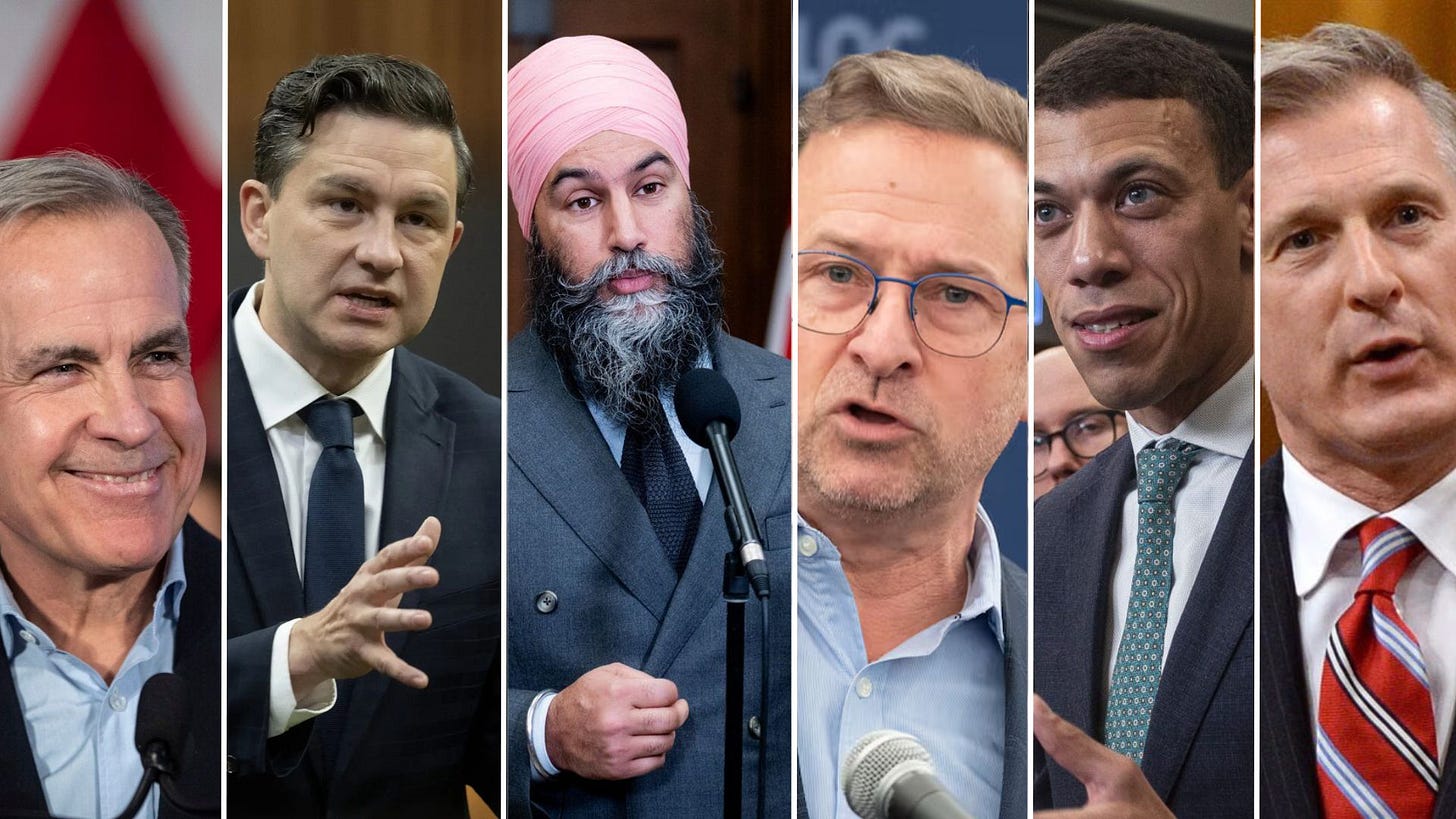Canada’s 2025 Election: Candidate Breakdown and Who’s Best Suited to Face Trump’s Trade War
As Canadians get ready to vote on April 28, we look at the six-party leaders and their strategies for handling U.S. relations amid a trade war.
Canadians head to the polls on April 28 as Prime Minster Mark Carney triggers a spring election.
With Canada’s federal election called for April 28, party leaders are making their pitches to voters. Amid rising U.S.-Canada trade tensions, the race is shaping up to be a battle over economic strategy and diplomatic strength.
Prime Minister Mark Carney has set the stage for a fast-paced federal election, with Canadians heading to the polls on April 28, 2025. The snap election comes just weeks after Carney's appointment, and the looming trade war with the United States is dominating the campaign narrative. With Donald Trump threatening further tariffs on Canadian goods, the next prime minister will need to navigate high-stakes negotiations while protecting the nation’s economic stability.
From bold tax cuts to trade diversification strategies, each of the six major party leaders is offering a different vision for Canada’s future.
Here’s where they stand on U.S. relations, trade policies, and their plans to counter Trump’s aggressive tactics.
Mark Carney — Liberal Party (Nepean)
Background: The former Governor of the Bank of Canada and the Bank of England, Carney, stepped into the Liberal leadership following Justin Trudeau's resignation. With a reputation as a pragmatic economist, he promises a balanced approach to trade while strengthening domestic economic resilience.
Key Policies:
Create a Trade Resilience Task Force to respond to U.S. tariffs.
Diversify export markets by deepening trade relations with the EU and Indo-Pacific.
Offer middle-class tax cuts and eliminate the GST for some first-time homebuyers.
Approach to Trump: Carney is positioning himself as a steady, experienced negotiator who can hold firm against Trump’s aggressive trade tactics. He believes in using multilateral alliances, like the Comprehensive and Progressive Agreement for Trans-Pacific Partnership (CPTPP), to counter U.S. economic pressure.
Challenge: While Carney’s financial expertise is widely respected, his lack of elected political experience may be seen as a vulnerability on the campaign trail.
Pierre Poilievre — Conservative Party (Carleton)
Background: Poilievre, a veteran Conservative MP, has built his platform around dismantling what he calls “Liberal economic mismanagement.” He’s focused on reducing government intervention, lowering taxes, and removing trade barriers.
Key Policies:
Scrap the industrial carbon tax.
Cut the GST on new homes.
Prioritize energy exports to reduce reliance on the U.S.
Approach to Trump: Poilievre supports a more transactional relationship with Trump, aiming to minimize damage through direct negotiations. His pitch to voters is that a Conservative government will restore economic stability without capitulating to American demands.
Challenge: Critics argue that Poilievre’s willingness to align with Trump on trade could harm Canada’s environmental commitments and labor protections.
Jagmeet Singh — New Democratic Party (Burnaby South)
Background: As NDP leader since 2017, Singh has championed progressive policies, including affordable housing, universal pharmacare, and climate action. He blames both the Liberals and Conservatives for failing to protect Canadian workers from unfair trade practices.
Key Policies:
Impose retaliatory tariffs on U.S. goods.
Support Canadian manufacturing by increasing domestic production.
Expand renewable energy infrastructure.
Approach to Trump: Singh’s strategy is to stand firm against Trump’s trade policies, arguing that Canada must become more self-reliant. He’s advocating for stronger protections for Canadian workers and small businesses.
Challenge: Singh’s aggressive stance on trade may escalate tensions and provoke further economic retaliation from the U.S.
Yves-François Blanchet — Bloc Québécois (Beloeil—Chambly)
Background: Blanchet’s primary focus is advancing Quebec’s interests. He’s pushing for greater provincial autonomy and protection of Quebec’s agricultural and manufacturing sectors.
Key Policies:
Implement Quebec-specific trade protections.
Promote local industries and clean energy initiatives.
Secure subsidies for affected Quebec industries.
Approach to Trump: Blanchet has framed Trump’s tariffs as a direct threat to Quebec’s economy. He’s calling for aggressive countermeasures to shield the province from economic fallout.
Challenge: While his regional focus resonates with Quebec voters, his limited interest in national economic policy may hinder his appeal outside the province.
Elizabeth May & Jonathan Pedneault — Green Party (Saanich—Gulf Islands for May; Laurier—Sainte-Marie for Pedneault)
Background: May, a veteran environmental activist, is once again leading the Greens, now alongside co-leader Pedneault. They’re prioritizing climate action, arguing that sustainable policies will also strengthen Canada’s economic resilience.
Key Policies:
Develop a clean energy corridor for exports.
Impose tariffs on high-carbon imports from the U.S.
Expand partnerships with EU nations on renewable technology.
Approach to Trump: The Green Party advocates for reducing Canada’s economic reliance on the U.S. by accelerating clean energy investments and expanding export markets.
Challenge: Their ambitious climate policies may face pushback from industries reliant on U.S. trade.
Maxime Bernier — People’s Party of Canada (Beauce)
Background: Bernier, a former Conservative MP, leads the far-right PPC with a focus on “Canada First” policies. He has called for withdrawing from international trade agreements to protect domestic industries.
Key Policies:
Abolish the carbon tax.
Promote resource extraction and exportation.
Reduce foreign economic influence.
Approach to Trump: Bernier views Trump’s protectionism as an opportunity for bilateral trade negotiations. He supports reducing Canada’s participation in multilateral trade agreements.
Challenge: Bernier’s isolationist approach may severely damage Canada’s global standing and economic stability.
Analysis:
As the election in April approaches, Canadians face a critical decision. Carney's expertise in global finance positions him as a reliable candidate for navigating the trade war. Poilievre’s pro-business stance attracts voters looking for economic growth, while Singh presents a worker-focused plan for resilience. Blanchet’s Quebec-first approach and the Greens' climate-driven policies add further dimensions to the race.
Ultimately, the candidate best equipped to confront Trump will need to balance assertive diplomacy with economic pragmatism. Voters must consider who can defend Canada’s interests while maintaining stable cross-border relations.
Stay informed. Stay engaged. Mark your calendars for April 28.


